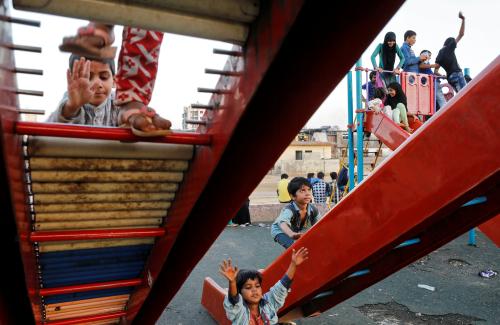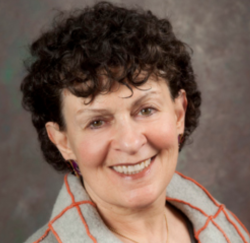This post originally appeared on the Stanford Social Innovation Review (SSIR) as part of the Preparing Today’s Youth for Tomorrow’s World series produced in partnership with SSIR and CUE.
What if a bench were not just a bench? What if instead, it had puzzles on the back that could be arranged and rearranged to produce three separate pictures? Or if that bench became a scale that could measure the difference in weight when two people sat on it instead of one? Or if it had boards designed to flip back and forth at 2-inch intervals, so that we could measure the length of a leg, or a shoe. What if….
Low-income children around the world often don’t have access to the kinds of mental stimulation that is commonplace in middle-income homes. Blocks and puzzle pieces are not strewn across living room floors, and shelves are often cluttered with extra diapers rather than age-appropriate books for children to browse. The consequence? Lower income children often enter formal schooling with many fewer skills than their wealthier peers—setting a trajectory for an achievement gap that often plagues them through high school and beyond. Indeed, in our own work, we see not only a large language gap based on family income by the time children are 3 years old, but also a growing divide in precisely the kind of spatial skills (such as rotation) that some children gain when playing with blocks and puzzles that support mathematical readiness.
The challenge is formidable, and leads many in policy circles to champion education as a way to even the playing field. If only we built high-quality preschools, the argument goes, all children would “race to the top” with “no child left behind.” Of course, educational reform is one part of the solution. And studies often show that although high-quality preschools are difficult to scale, gold standard programs like those in the state of New Jersey or in the city of Boston do move the needle for children raised in poverty. The same data, however, show that the cognitive stimulation gained in preschool needs to be reinforced at home and in later grades if it is to have sticking power. By way of analogy, one healthy meal a day is surely better than none, but to build strong bones and muscles, we must broaden access to fresh fruits and vegetables so that children are well-fed throughout their lifespans.
Schooling offers a powerful antidote to those growing up in poverty, but it is unlikely to be the golden ticket on its own. Two facts support that point. First, schooling often begins at age 4 or 5, so even universal preschool programs of high quality will miss the formative years of 0 to 3. Moreover, several scientists have calculated that children enrolled full-time only spend 20 percent of their waking time in school.
How might we capitalize on the other 80 percent of children’s waking time, when they are not in school?
That question brings us back to the ideas about the benches. What if we transformed places where people naturally go—places where people wait—into learning landscapes that provide opportunities to spark conversation and learning? Whether we live in an urban hub or a rural outpost, we all have to get groceries. So in a 2015 study, we asked if we could transform a supermarket into a kind of children’s museum by posting conversation prompts throughout the store. A bright sign with a friendly cow, posted conspicuously at the dairy section, might read, “I am a cow who gives you milk. What else comes from a cow?” Signs like this got parents and children talking. In fact, there were 33 percent more conversations in supermarkets with mainly low-income families when the signs were up than when they were down. A supermarket study in Duncan Village, South Africa, showed similar results. With Too Small to Fail, an initiative of the Clinton Foundation and The Opportunity Institute, we are now extending our reach to other so-called “trapped spaces,” such as laundromats. And we are working with an organization called South Africa Partners to engage local groups in expanding the project into South African hospital clinics, where parents often wait for hours with their children.
We can also capitalize on public spaces that are serving the common good. Families wait at bus stops. What could they be doing as they wait? Might they play with a puzzle bench or find hidden figures in a learning sculpture garden or even play a game of hop-scotch specifically designed to foster impulse control? To take advantage of such opportunities for playful learning, we launched the Urban Thinkscape project. Firmly grounded in findings from education research, the project marries architecture with the psychology of learning. Currently we are working with Israeli architect Itai Palti to design activities that challenge the mind while generating engagement between caregivers and children. The first installation is due in April 2017 in West Philadelphia, on the very lot where Martin Luther King started his Freedom March.
Finally, we might ask how we can infuse everyday parks with learning and conversation opportunities. In the city of Tulsa, Oklahoma, there are plans to build a magnificent park that will engage the community in outdoor activities while also promoting sustainability in the center of the city. This project, entitled “A Gathering Place for Tulsa,” is replete with outdoor facilities such as climbing equipment that will be the envy of cities around the world. How could this opportunity for jumping and scaling heights be transformed into a potential springboard for calculating math? Simply adding notches on the poles and on the ground to let children know just how far they climbed or jumped? We suggested just that to the developers. Our own Ultimate Block Party offers another example of public parks’ potential to become learning spaces. Through the project, we showcased to parents and caregivers the science behind how children learn reading, math, and social skills through 28 interactive activities dotted around Central Park, Baltimore’s Inner Harbor, and Toronto’s Fort York Park.
Bottom line? Our schools cannot resolve the inequities that children face by themselves. Even our greatest teachers need and deserve the support that comes from beyond school walls—from homes and from communities.
And so we come back to the big idea: Using cities as agents of change and urban revitalization and opportunities for creating learning landscapes. Once we change the lens on how we view everyday environments, we can begin to see the learning potential there. We can design environments that foster a breadth of skills—from communication, to collaboration, to critical thinking—on our everyday walks and in our everyday neighborhoods. And once we change that lens, it is not so hard to imagine ordinary benches morphing into puzzles, and cities and towns transforming into vibrant learning landscapes.
The Brookings Institution is committed to quality, independence, and impact.
We are supported by a diverse array of funders. In line with our values and policies, each Brookings publication represents the sole views of its author(s).









Commentary
Transforming cities into learning landscapes
November 2, 2016